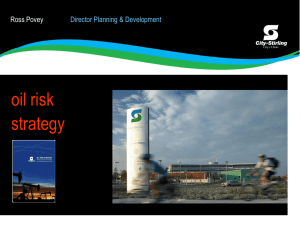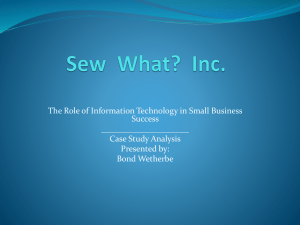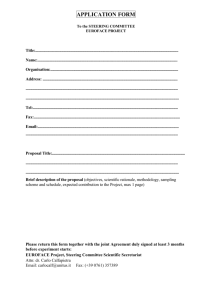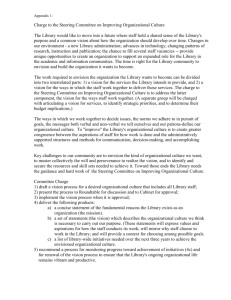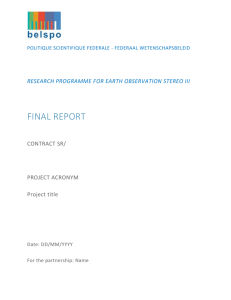Progress Report on Stress Management Work Group SHE 11/08 No3
advertisement
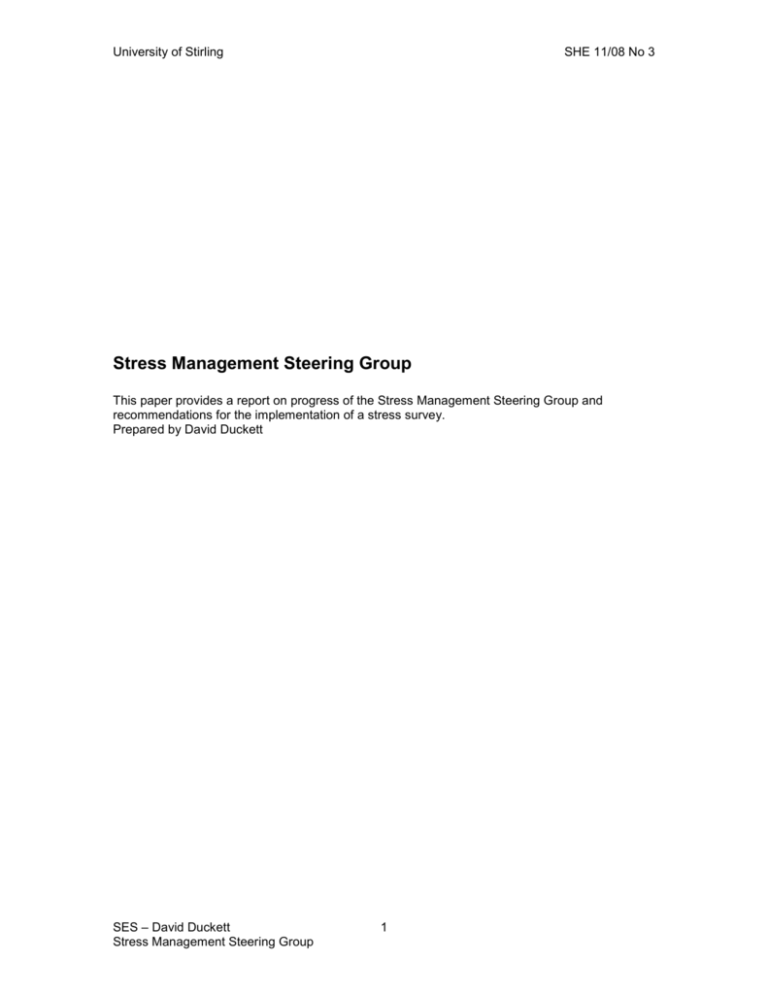
University of Stirling SHE 11/08 No 3 Stress Management Steering Group This paper provides a report on progress of the Stress Management Steering Group and recommendations for the implementation of a stress survey. Prepared by David Duckett SES – David Duckett Stress Management Steering Group 1 University of Stirling SHE 11/08 No 3 Stress Management Steering Group Report on Progress to date Background: The subject of stress was first raised at the University Safety Committee meeting in 2003 where it was acknowledged that this was an important safety/ wellbeing issue that required risk assessment. However, there were concerns about stress risk assessment process and how this would be handled sensitively and confidentially. In 2004 a small group was set up to undertake a stress gap analysis and a report was presented to the Safety Committee later that year. During 2005 – 2007 a number of stress surveys were reviewed but none undertaken. However, a University Policy on stress was written and approved by SHE in November 2007. This created new impetus to managing stress and in May 2008 the SHE committee approved the setting up of a stress management steering group. Remit of the Stress Management Steering Group There is already a good resource of experience and knowledge on stress management at the University and the stress management steering group has been set up to make use of this resource. Members of the Group are: David Duckett - Safety and Environmental Services Claudia McComish - Human Resources Douglas Robertson - Department of Applied Social Science Vivien Swanson - Psychology Brodie Patterson - Nursing and Midwifery; UCU Simon Booth – Information Services Helen Rowell - Occupational Health (OHSAS) Robert McLean - Unison George McLeod - Unite Vivien Alexander – Unison The remit of the group is: - - to consider and decide upon a methodology to obtain suitable information that will enable a stress risk assessment to be performed. It is likely that most information will be gathered by the use of a staff survey, although information from other sources should also be considered e.g. work related sickness absence records and OH referrals. Consider how the information can be analyzed so that an assessment of stressors in the workplace can be achieved Report the findings of the risk assessment to the SHE committee together with suggestions for ways in which workplace stressors can be reduced. Ongoing review of stress management – to confirm that progress is being made. SES – David Duckett Stress Management Steering Group 2 University of Stirling SHE 11/08 No 3 Discussion of methodology Initially, five options for carrying out the survey were considered: - Use ‘Survey monkey’ to carry out the survey; Develop our own in house web based survey; Review existing surveys e.g. those developed by UCEA, ACAS, Work Positive, QoWL Use the group response system and invite representative groups of staff to attend; Carry out survey work as part of the Safety and Environmental Services office audit program of all departments. Main points of discussion: - - The development of the question set had to include the right type of questions and phrased in a non leading way. The question set must include the HSE’s Indicator tool but also questions on work life balance and biographical information (gender, department, part time/ full time etc) The software used to conduct the survey had to be easy to set up and had to be able to export the results to a suitable analytical software package. The survey must be seen to be conducted in a way that retained anonymity and there would have to be a process to deal with small numbers of responses from smaller departments so that individuals could not be identified. There was a feeling that a survey conducted form an independent source would have a higher response rate than one implemented form within the University The were concerns over the time needed to set up the survey and to analyze the results Paper copies of the survey would be required for those who do not have access to a PC and there were concerns at how this would be administered and how/ who would input the responses into the survey tool and at the same time retain anonymity Having considered all of these issues, the Group felt that two options were suitable: a survey conducted using Web CT and implemented in house; and a survey administered by QoWL. The Group also looked carefully at the Quality of Working Life (QoWL) survey which has been running for a number of years and was developed by chartered psychologists at the University of Portsmouth. QoWL Ltd is now a university spin out company and research unit that provides surveys and expert consultancy services designed to improve quality of working life for employees. The survey would be administered free of charge and a summary report provided. Recommendation 1: After much discussion it was agreed that participation in the 2008/09 free QoWL survey would be the best option for the University Benefits of using QoWL: - - The survey incorporates 3 psychometric tools: Work related quality of life scale, which considers general wellbeing, home/work interface, job satisfaction, control at work, working conditions, stress at work; Workplace wellbeing outcome scale which considers perceptions, relationships, intention to stay, quality of supervision, support, levels of anxiety; the HSE stress standards scale job demands, control, support, relationships, role and change. QoWL provide free of charge the set up of the question set, templates for communicating the survey to staff, the independent implementation of the survey, a summary report Although he survey is designed to be web based, paper copies can be sent out and results collated for a small charge (<£200) The results can be benchmarked against other Universities (a database of 10 Universities exists at present, although more are taking part during 2008/09) SES – David Duckett Stress Management Steering Group 3 University of Stirling - SHE 11/08 No 3 The information remains anonymous and the analysis and basic interpretation is done for us by QoWL – the difficulty with running our own survey would be the handling and analysis of the information, the time and expertise to do this and the interpretation of the results The free survey provides a basic analysis and summary report (attached as appendix 1). The basic analysis and summary report provides enough information to identify the scale of stress and how University of Stirling compares with the HE benchmark for those that have taken part. The report does not provide detailed breakdown analysis at department level so it would not be possible to identify specific departments where levels of stress was scoring high or low. However, QoWL are also able to provide a full detailed report that gives full analysis of the information and a much more in depth executive summary. A example of the contents of the full report is provided in appendix 2. This would enable departments to be benchmarked on all of the indicators against the University of Stirling average, enabling much more specific interventions to be implemented at department level. There is no requirement to decide on the level of reporting until after the survey has taken place. Recommendation 2: The survey’s basic analysis and summary report will indicate the overall uptake and success of the survey and the position of the University in terms of Quality of Working Life. However, if the uptake is good and there is a strong indication of there being good information coming from a much more in depth analysis then it would be worthwhile paying QoWL for the more in depth report. Depending on the categories of analysis requested the cost of this would be in the range of £6k to £12k. Communication The Group has still to fully discuss the way the survey will be communicated to staff, although QoWL are able to assist in the process by offering template documents. However, QoWL run 1 day seminars on Improving Wellbeing and preventing Stress in Universities – currently these are being held in Huddersfield (16 December) and Central London (17 December). In addition, QoWL would be able to run an in house seminar here at Stirling for a fee in the region of £1000. An in house 1 day seminar, provided for the Stress Management Group and also some Service Directors and Academic HOD’s, would be a very useful way of getting engagement with the QoWL process prior to the survey taking place and may be effective in increasing the overall uptake of the survey. A summary of the seminar is provided in appendix 3. Recommendation 3: Run a QoWL 1 day seminar at University of Stirling (cost circa £1k) for 12 – 16 people (Stress Management Group plus some Service Directos and Academic HOD’s) to generate engagement with the QoWL survey process prior to the survey taking place. SES – David Duckett Stress Management Steering Group 4 University of Stirling SHE 11/08 No 3 Appendix 1 – Summary report (double click on title page to open adobe document) Appendix 2 – Full report (double click on title page to open adobe document – this is a long document – suggest do not print) SES – David Duckett Stress Management Steering Group 5 University of Stirling SHE 11/08 No 3 Appendix 3 – QoWL 1 day seminar content summary Content summary Part One: Awareness and Measurement - Introductions What is Quality of Working Life (QoWL) and why is it important? How is QoWL measured? The Work-Related Quality of Life (WRQoL) scale QoWL, Stress and Wellbeing: how are they linked? QoWL research and benchmarks in UK Universities: WRQoL factors HSE Stress factors Workplace Wellbeing Outcomes Other important findings from the research What predicts stress and wellbeing in universities? Assessing and benchmarking QoWL in your University Part Two: Application, Process and Making Improvements - Introduction to using QoWL as a framework and process for Organisational Development Five specific QoWL applications: Staff survey, Wellbeing policies, Investors in People, Stress Risk Assessment, and Health/Wellbeing Promotion Constructing a QoWL Statement Action planning with QoWL Case Study Making improvements to QoWL: what kinds of interventions are likely to work and why Specific QoWL interventions e.g. management development, wellbeing initiatives Evaluating performance improvements Next steps SES – David Duckett Stress Management Steering Group 6



